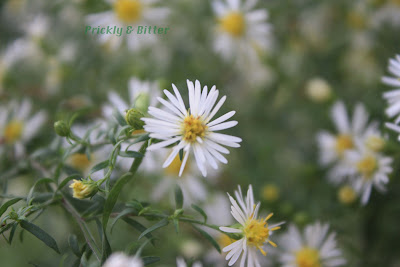Saturday, October 6, 2012
The blueberry-like white aster
Species name: Symphyotrichum ericoides
Common name: white aster, heath aster
Location: Ontario
This species of aster is native to much of North America, from Canada all the way south to Mexico. It has been introduced as an ornamental plant around the world, and is sold as a popular garden plant. One of the common names, the heath aster, comes from the fact that the leaves are notably not aster-like; they are instead very thick and almost bristle-like, which is characteristic of the blueberry family (or Ericaceae). For Latin names, wherever you see the ending "-oides" at the end of a species epithet (the "second name" of a species), that means "looks like." Like most white flowers with yellow middles, with multiple ray florets and disc florets (i.e. anything that looks like a daisy), this plant used to be classified in the genus Aster until DNA analysis showed it was in a different genus.
The story of this plant being sold in nurseries for ornamental usage is a long and complicated one, and shows how important it is to be able to identify plants when you're landscaping a garden. This is by far the most common "small, daisy-like plant" sold in garden stores, carrying the name "white aster" or "heath aster." Unfortunately, very little of what is being sold is actually the correct species of plant. More commonly it's misidentified S. dumosum, S. lateriflorum, S. pilosum or S. racemosum. This isn't a real problem in Canada and the United States since all four of these other species are also native, but in Europe this could be a big problem since only two of these species, S. dumosum and S. pilosum, can become invasive. Always make sure you know what you're buying and try to identify the plant yourself if you can (if the plant is mature enough to identify!). This problem has apparently been occurring continuously since the mid-19th century!
Most Symphyotrichum species are hardy, and resistant to infections. The exception, however, is when the plants are planted in close proximity with other plant species, and planted where the soil can not dry out fully between waterings. The roots of this plant (and the stem at soil level) are very susceptible to fungal infections, but this problem is all but eliminated when the plant is on its own in a sunny area. Something to keep in mind if you're going to be landscaping a garden in the spring.
Subscribe to:
Post Comments (Atom)




No comments:
Post a Comment